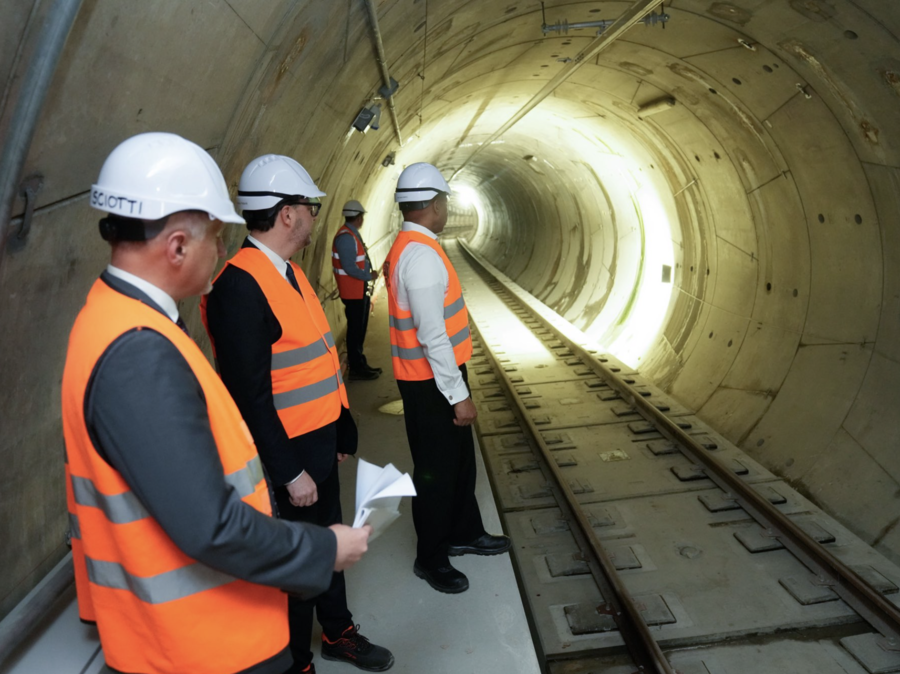From the Big Apple to the Big Hole. New York City Mayor Eric Adams, in Italy’s capital for two days, today went with Rome Deputy Mayor of Mobility Eugenio Patanè to see for himself the subway construction site that runs through downtown Rome, and his photo with the helmet on his head is already provoking all kinds of jokes.
What is triggering the well-known satirical instinct of Roman citizens is not the New York mayor, but the contrast between Rome and the city that never sleeps, where the subway (as old and problematic as it may be) has existed for 120 years, while only the third line is currently being painstakingly built in Rome. Yet in the capital’s chaotic traffic, it remains by far the fastest way to get around, for those lucky enough to live near one of the stations.
Because Rome’s subway is like the proverbial building of St. Peter’s: it never ends, for the very good reason that planting a spade in the soil of the Eternal City always means bumping into some archaeological find (which you have to investigate, photograph, catalog, and often eventually cover up, perhaps leaving some half of a wall under glass in a subway station). Not to mention political turnarounds which can lead to changes in contracts and regulations. Or sometimes even the occasional investigation by the judiciary.
Line B, which now has 26 stops, despite its name was the first to be built, starting in the 1950s (the project even dated back to the early 1940s under Mussolini). It became B only when the second line, called A, arrived, intersecting it almost at right angles, whose construction took a whopping 17 years, amid hiccups and interruptions (one of 5 years), from 1963 to 1980 (yet they hoped it would be ready for the 1975 Jubilee: the year of the remission of sins when millions of Catholic pilgrims flock to Rome; it happens every 25 years).
The story of the C line began … in the 1990s, with the first section not opening until 2013 (yet they hoped it would be ready for the 2000 Jubilee). The most substantial part, from San Giovanni to Piazzale Clodio, passes under the entire historic center (Piazza Venezia, Piazza Argentina, the Vatican…). The construction sites have been open for over a decade, often inactive, mute witnesses to the difficulties of Roman transportation. But with the arrival of the Jubilee of 2025 now just around the corner, it is clear that the work will take much longer.
Adams, who is in Rome for a peace conference organized by a Vatican institution, the World Meeting on Human Fraternity, and will meet with Pope Francis on Saturday morning, went to the construction site of the Colosseum stop, beneath the symbolic monument of the ancient empire. There is already a Colosseo station on the B line; the new one will also have to join the nearby Piazza Venezia station. Above and below ground, two thousand years of history tower: the Forums, the columns, what remains of medieval Rome, all the splendors of Baroque Rome.
“On the ground in Rome under the Coliseum [sic]! We’re two international cities full of tourists, visitors and the everyday working people who make our cities run” wrote Adams on X. “Sharing our ideas and accomplishments on infrastructure, public transit and everything big cities need will only make us stronger”. The Roman citizens can only hope.
Eric Adams’s schedule in Rome on Friday also includes a visit to the Urban Regeneration Site of Testaccio, a series of roundtable discussions with Nobel Peace Prize Laureates, a meeting with the Mayor of Rome Roberto Gualtieri, a virtual media briefing to discuss his trip to Italy, a tour of the Vatican Museums and the Sistine Chapel, attending Cardinal Mauro Gambetti’s opening remarks for the World Meeting on Human Fraternity and finally, the World Meeting on Human Fraternity dinner.











